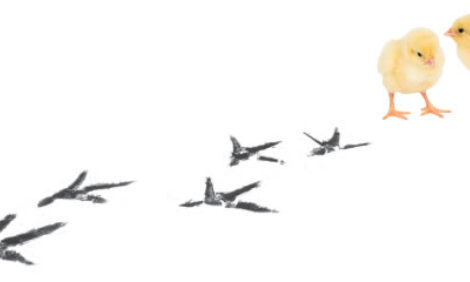



GLOBAL POULTRY TRENDS 2013: Africa's Chicken Growth Exceeds World Average
Over the last decade, there has been a five per cent annual increase in chicken meat output from Africa countries, which has increased the continent's share of global production. In Oceania, the increase has been a little slower but further growth in output is forecast, according to industry analyst, Terry Evans.African Poultry Meat Growth Betters Global Average
Between 2000 and 2011, chicken meat production in Africa expanded by almost five per cent per year as output climbed to 4.62 million tonnes. As global growth during this period averaged a little below four per cent per year, Africa increased her contribution to the world total from 4.7 to 5.1 per cent (Table 1).
The individual country breakdown (Tables 2 and 3) reveals that all bar seven nations produced less than 100,000 tonnes a year in 2011. The seven biggest producers - with a combined output of 3.64 million tonnes - accounted for almost 80 per cent of the regional total. However, as is clear from Figure 1, between 2000 and 2011 significant growth occurred in only three of these – South Africa, Egypt and Morocco.
The size ranking (Table 3) shows that South Africa dominates chicken meat production with an annual output of nearly 1.5 million tonnes accounting for almost one-third of the regional total in 2011. According to the South African Poultry Association (SAPA), the number of broilers slaughtered in 2010 was 969 million rising to 979 million in 2011 and further to 997 million in 2012.
Based on day-old parent pullet placings and specific industry production standards, the latest estimate for 2013 of 1,054 million birds, points to an increase of almost six per cent on 2012. An average slaughter weight of around 1.4kg per bird would give a meat yield of close on 1.5 million tonnes. However, SAPA is in the process of re-addressing the industry standards which could alter output estimates.
More important to the level of current production is the impact of imports on domestic production. South Africa’s receipts of relatively low-priced frozen chicken meat have grown from around 191,000 tonnes in 2008 to nearly 371,000 tonnes in 2012, when they represented around one-fifth of national broiler consumption. This increase could well have contributed to a number of small to medium-sized producers going out of business, while two of the country’s largest companies - Country Bird Holdings and RCC Foods (formerly Rainbow Chicken) - have recently reported a decline in yearly earnings of 17 per cent and 92 per cent, respectively. In an attempt to offset the impact of imports on earnings, Country Bird is diversifying its product range for the fast-food sector of the market.
Chicken meat production in Egypt has suffered periodic set-backs since highly pathogenic avian influenza (HPAI) H5N1 was first detected in 2006 and has since become endemic in several governorates. Despite this disease causing considerable economic loss to producers, output climbed dramatically by more than eight per cent per year between 2008 and 2011 when it came close to 800,000 tonnes (Table 2 and Figure 1).
From 2000 to 2011, chicken meat production in Morocco expanded by some 8.5 per cent per year, with output coming close to 586,000 tonnes in 2011. However, higher input costs and lower market prices in the past few years have cut production. Returns improved earlier this year and there is optimism regarding the future and a recovery in production levels.
Nigeria is the seventh largest country in the world with a human population currently of around 175 million expected to exceed 200 million by 2020. Between 2000 and 2010, chicken output rose by more than six per cent per year. According to the FAO data, the growth came to a halt in 2011 at 285,000 tonnes. Occasionally, if the data for the most recent year has not been confirmed, the FAO will insert the previous year’s figure in order to arrive at a regional total. However, the Poultry Association of Nigeria maintains that broiler production is much higher than this.
While the industries in Algeria, Libya and Tunisia made some headway during the past decade or so, clearly as indicated in Figure 1, the growth has been much less dramatic than in the top three producers in the region.

Oceania: Australia’s Production Tops One Million Tonnes
Chicken meat output in Oceania expanded by around 4.6 per cent per year between 2000 and 2011 to exceed 1.2 million tonnes and the indications are that expansion has since continued to around 1.3 million tonnes in 2013. As is clear from Table 4, the region’s total is almost entirely dependent upon the levels of production in Australia and to a much lesser extent, New Zealand, as these two provide almost 98 per cent of total output.
In 2011, chicken meat production in Australia topped one million tonnes for the first time, its industry having grown by almost five per cent per year.
The Australian Bureau of Agricultural and Resource Economics and Sciences (ABARES) foresees growth continuing in the short- to medium-term. During 2013-14, a three per cent increase is anticipated to 1.08 million tonnes while by 2017-18, output is expected to rise to around 1.2 million tonnes. Chicken meat accounts for 95 per cent of total poultry meat in Australia. Just two major companies supply around three-quarters of national chicken output. The average eviscerated weight is around 1.9kg per bird compared with a global figure of just over 1.5kg.
Production in New Zealand in 2011, at almost 160,000 tonnes, showed a near four per cent per year gain over the 2000 level (Table 4) although the increase when compared with 2006 was less than 9,000 tonnes. Between 2007 and 2010, output failed to reach 150,000 tonnes.
The production data for the other countries in the region showed little movement during the review period with the exception of Fiji where output in 2011, at just 15,200 tonnes, was almost double the level in year 2000.
November 2013












